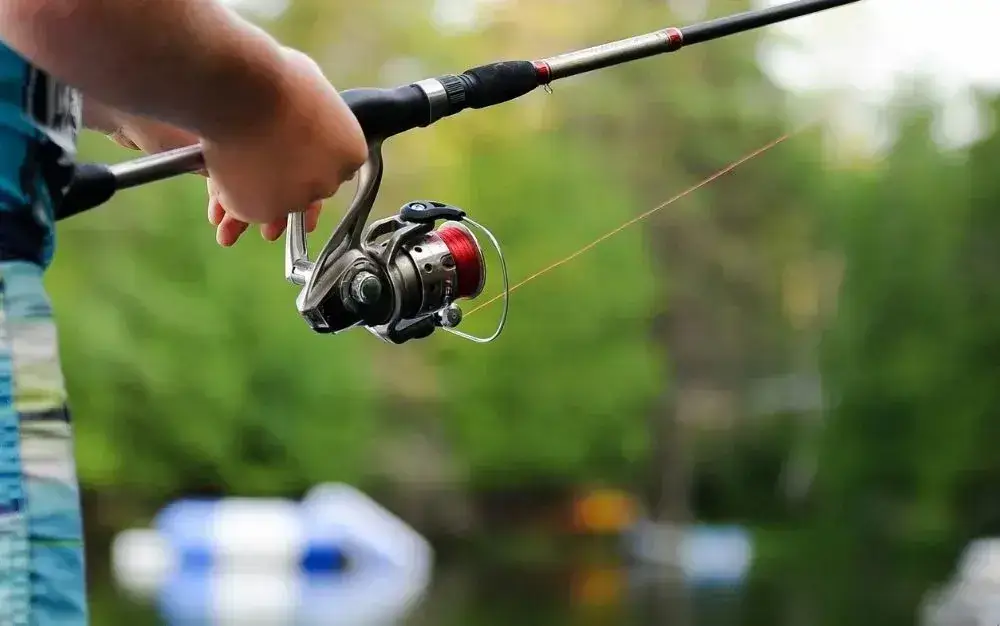Max drag on a reel is the amount of force that can be applied to a fishing line before it begins to spool out. This limit helps prevent you from overloading your reel and breaking the line.
Most reels have a max drag of between 10-25 pounds, though some can go up to 50 or even 100 pounds. Therefore, when choosing a reel, it’s important to consider what type of fish you’ll be targeting and what size Max Drag is necessary to land them.
What Is Max Drag on a Reel, and Why Is It Important in Fishing?

Drag is one of the most important aspects of fishing reel performance. It is simply the resistance to the line being pulled off the spool by a fish.
The faster the fish swims, the more drag is required to keep the line tight and prevent it from being stripped off the reel.
There are two types of drag systems on fishing reels, star drag, and lever drag. Star drag systems are the most common and use a simple clicker mechanism to apply pressure to the line. Lever drags are found on higher-end reels and offers more precise control over drag settings.
There are a few things to consider when setting the drag on your reel. The first is the type of fish you are targeting. Larger, more powerful fish will require more drag to prevent stripping the line off the reel.
The second is the type of line you are using. Heavier lines can handle more drag than lighter lines before breaking.
The third and final thing to consider is the water conditions you are fishing in. Strong currents or fast-moving water can strain your line and reel, so you may need to increase the drag to compensate.
It is generally better to err on the side of too much drag rather than too little. It is much easier to slow a fish down by using more drag than trying to speed one up by using less.
By having too much drag, you risk breaking your line or pulling the hook out of a fish’s mouth. However, by having too little drag, you may never be able to land that fish.
Remember, the goal is to have fun and catch fish. So, experiment with different drag settings until you find what works best for you and your fishing conditions.
How Does the Amount of Drag Affect How Your Bait Behaves
The amount of drag on your reel can impact how your bait behaves in the water. For example, if you’re using live bait, too much drag can cause it to swim erratically or even break free from your line.
Conversely, not enough drag can allow fish to take more line than you’d like, increasing the risk of getting away.
There are a few factors to consider when setting the drag on your reel, including the type of fish you’re targeting and the size of your line.
In general, it’s best to start with a lighter drag and increase it if necessary. Of course, you can always add more drag, but it’s much harder to take it away once you’ve set it.
One of the most important things to remember when fishing with live bait is that you need to be able to control the amount of drag on your reel.
If you can’t do this, you risk losing fish or even breaking your line. The best way to avoid this is to start with a lighter drag and increase it.
What Are Some Common Ways to Adjust the Drag on Reel?

One common way to adjust the drag on a reel is by using a backing. This material, usually nylon or Dacron, is wound onto the spool before the fishing line.
The amount of backing used will determine how much drag is applied to the reel. Another way to adjust the drag is by using different drag washers.
These washers are usually made of cork or felt and can be placed under the spool to increase or decrease the amount of drag.
Finally, many reel manufacturers offer different drag systems that can be swapped out to change the amount of drag on the reel.
When choosing a drag system for your reel, it is important to consider the type of fishing you will be doing. for example, if you are using your reel for light tackle fishing, you will want a drag system that can be adjusted to provide a smooth, consistent drag.
How Do You Know When to Increase or Decrease the Drag?
The amount of drag on your reel is extremely important when fishing. Too much drag, and your line could snap.
Not enough drag and the fish could swim away with your bait. So, how do you know when to increase or decrease the drag on your reel?
Here are a few tips:
- If you use live bait, you will want to reduce the drag. This is because live bait is more likely to swim away if there is too much drag on the line.
- If you are fishing in open water, you will want to increase the drag. There is a greater chance that the fish will swim away if there is not enough drag on the line.
- If you use artificial bait, you will want to increase the drag. This is because artificial bait is less likely to swim away if more drag is on the line.
- If you are fishing in a river, you will want to decrease the drag. This is because rivers have a strong current that can quickly pull your line away without too much drag.
- If you are fishing in a lake, you will want to increase the drag. This is because lakes have a weaker currency, and it is less likely that the fish will swim away if there is more drag on the line.
By following these tips, you should be able to fine-tune the amount of drag on your reel for optimal results while fishing.
What Are Some Common Problems with Incorrect Drag Settings
Setting the drag too tight is a common mistake that anglers make. If the drag is set too tight, it can put unnecessary strain on the fish, making it more difficult to reel in.
Additionally, if the drag is set too tight and the fish makes a sudden run, it can break the line.
Another common problem with incorrect drag settings is setting the drag too loose. If the drag is set too loose, it can cause the fish to get away more easily.
Additionally, if the fish makes a sudden run while the drag is set too loose, it can pull the line from the reel, making it more difficult to reel in the fish.
To avoid these problems, it is important to set the drag correctly for the type of fish you are fishing for. For example, if you are fishing for a smaller fish, you will want to set the drag tighter than fishing for a larger fish.
Although, if you are using a lighter line, you will want to set the drag tighter than if you were using a heavier line.
How Can You Tell If You Have the Right Amount of Drag Set on Your Reel?

The amount of drag on your reel is extremely important, and if it’s not set correctly, you could lose the fish. So, how can you tell if you have the right amount of drag set on your reel?
You’ll want to keep in mind a few things when setting the drag on your reel. First, you’ll want to make sure that the drag is set tight enough so the fish can’t pull the line out of the reel.
Second, you’ll want to make sure that the drag isn’t too tight, or else you’ll risk breaking your line.
To test the drag on your reel, tie a small weight to the end of your line and then let the weight hang over the edge of the reel.
Next, slowly increase the drag until the weight starts to slip. At this point, you’ll know that you have the right amount of drag set on your reel.
If you’re ever in doubt about whether or not you have the right amount of drag set on your reel, it’s always better to err on the side of caution and set the drag a little tighter. That way, you’ll be sure that you won’t lose the fish, and you won’t risk breaking your line.
Now that you know how to set the drag on your reel, go out and try. You might be surprised at how much difference the right amount of drag can make.
Final Thoughts
When it comes to fishing, there is a lot of debate surrounding what is the best way to do things. This is especially true when it comes to reeling in fish.
Some people swear by using max drag on their reel, while others say this isn’t necessary. So, what is the truth?
Well, the answer may vary depending on who you ask. However, we believe that using max drag on your reel can benefit certain situations.
For example, if you are fishing for a big fish, then using max drag can help you tire them out more quickly. This can make it easier to reel them in and avoid a long and drawn-out battle.
That being said, there are also some drawbacks to using max drag. First, it can put a lot of strain on your reel and line. This can lead to premature wear and tear, which you want to avoid.

